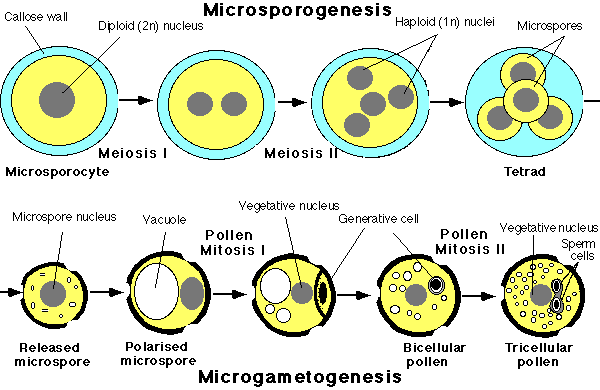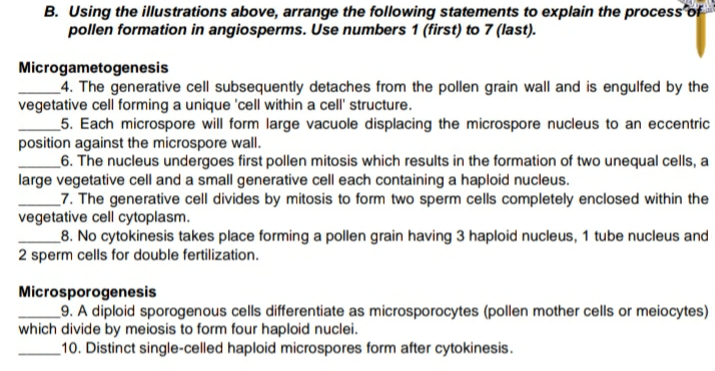B. Using the illustrations above, arrange the following statements to explain the process of pollen formation in angiosperms. Use numbers 1 (first) to 7 (last). Microgametogenesis _4. The generative cell subsequently detaches from the pollen grain wall and is engulfed by the vegetative cell forming a unique 'cell within a cell' structure. _5. Each microspore will form large vacuole displacing the microspore nucleus to an eccentric position against the microspore wall. _6. The nucleus undergoes first pollen mitosis which results in the formation of two unequal cells, a large vegetative cell and a small generative cell each containing a haploid nucleus. _7. The generative cell divides by mitosis to form two sperm cells completely enclosed within the vegetative cell cytoplasm. _8. No cytokinesis takes place forming a pollen grain having 3 haploid nucleus, 1 tube nucleus and 2 sperm cells for double fertilization. Microsporogenesis _9. A diploid sporogenous cells differentiate as microsporocytes (pollen mother cells or meiocytes) which divide by meiosis to form four haploid nuclei. 10. Distinct single-celled haploid microspores form after cytokinesis.
B. Using the illustrations above, arrange the following statements to explain the process of pollen formation in angiosperms. Use numbers 1 (first) to 7 (last). Microgametogenesis _4. The generative cell subsequently detaches from the pollen grain wall and is engulfed by the vegetative cell forming a unique 'cell within a cell' structure. _5. Each microspore will form large vacuole displacing the microspore nucleus to an eccentric position against the microspore wall. _6. The nucleus undergoes first pollen mitosis which results in the formation of two unequal cells, a large vegetative cell and a small generative cell each containing a haploid nucleus. _7. The generative cell divides by mitosis to form two sperm cells completely enclosed within the vegetative cell cytoplasm. _8. No cytokinesis takes place forming a pollen grain having 3 haploid nucleus, 1 tube nucleus and 2 sperm cells for double fertilization. Microsporogenesis _9. A diploid sporogenous cells differentiate as microsporocytes (pollen mother cells or meiocytes) which divide by meiosis to form four haploid nuclei. 10. Distinct single-celled haploid microspores form after cytokinesis.
Biology 2e
2nd Edition
ISBN:9781947172517
Author:Matthew Douglas, Jung Choi, Mary Ann Clark
Publisher:Matthew Douglas, Jung Choi, Mary Ann Clark
Chapter23: Protists
Section: Chapter Questions
Problem 6RQ: Mitochondria most likely evolved by ___________ . a photosynthetic cyanobacterium cytoskeletal...
Related questions
Concept explainers
Question

Transcribed Image Text:Microsporogenesis,
Callose wall
Diploid (2n) nucleus
Haploid (1n) nuclei
Microspores
Meiosis I
Meiosis ir
Microsporocyte
Tetrad
Vegetative nucleus
Microspore nucleus
Vacuole
Generative cell
Yegetative nucleus
Pollen
Mitosis I
Pollen
Mitosis II
Sperm
'cells
Released
Polarised
Bicellular
Tricellular
microspore
microspore
pollen
pollen
Microgametogenesis

Transcribed Image Text:B. Using the illustrations above, arrange the following statements to explain the process of
pollen formation in angiosperms. Use numbers 1 (first) to 7 (last).
Microgametogenesis
_4. The generative cell subsequently detaches from the pollen grain wall and is engulfed by the
vegetative cell forming a unique 'cell within a cell' structure.
5. Each microspore will form large vacuole displacing the microspore nucleus to an eccentric
position against the microspore wall.
_6. The nucleus undergoes first pollen mitosis which results in the formation of two unequal cells, a
large vegetative cell and a small generative cell each containing a haploid nucleus.
_7. The generative cell divides by mitosis to form two sperm cells completely enclosed within the
vegetative cell cytoplasm.
_8. No cytokinesis takes place forming a pollen grain having 3 haploid nucleus, 1 tube nucleus and
2 sperm cells for double fertilization.
Microsporogenesis
_9. A diploid sporogenous cells differentiate as microsporocytes (pollen mother cells or meiocytes)
which divide by meiosis to form four haploid nuclei.
_10. Distinct single-celled haploid microspores form after cytokinesis.
Expert Solution
This question has been solved!
Explore an expertly crafted, step-by-step solution for a thorough understanding of key concepts.
This is a popular solution!
Trending now
This is a popular solution!
Step by step
Solved in 2 steps

Knowledge Booster
Learn more about
Need a deep-dive on the concept behind this application? Look no further. Learn more about this topic, biology and related others by exploring similar questions and additional content below.Recommended textbooks for you

Biology 2e
Biology
ISBN:
9781947172517
Author:
Matthew Douglas, Jung Choi, Mary Ann Clark
Publisher:
OpenStax

Biology: The Unity and Diversity of Life (MindTap…
Biology
ISBN:
9781337408332
Author:
Cecie Starr, Ralph Taggart, Christine Evers, Lisa Starr
Publisher:
Cengage Learning

Biology: The Unity and Diversity of Life (MindTap…
Biology
ISBN:
9781305073951
Author:
Cecie Starr, Ralph Taggart, Christine Evers, Lisa Starr
Publisher:
Cengage Learning

Biology 2e
Biology
ISBN:
9781947172517
Author:
Matthew Douglas, Jung Choi, Mary Ann Clark
Publisher:
OpenStax

Biology: The Unity and Diversity of Life (MindTap…
Biology
ISBN:
9781337408332
Author:
Cecie Starr, Ralph Taggart, Christine Evers, Lisa Starr
Publisher:
Cengage Learning

Biology: The Unity and Diversity of Life (MindTap…
Biology
ISBN:
9781305073951
Author:
Cecie Starr, Ralph Taggart, Christine Evers, Lisa Starr
Publisher:
Cengage Learning